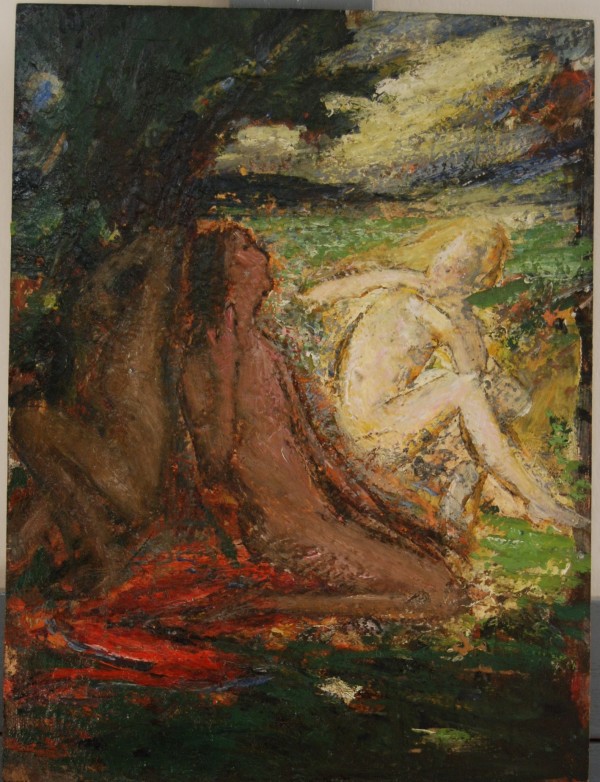-
Artist: Theresa Bernstein (American, 1890-2002)
“Born in Philadelphia to cultured immigrant parents, Bernstein showed an interest in art as a child.” (1)
“Her father was a textile manufacturer and her mother an accomplished pianist.” (2)
“She received her art education at the Philadelphia School of Design for Women (now Moore College of art) moving to New York City in 1912 and continued her studies in the studio of William Merritt Chase at the Art Students' League.” (3)
“In these early years she painted in an Ashcan style, influenced by John Sloan and other artists of the period who depicted the everyday life of the city in dark tones. New York Street (1912) and Waiting Room: Employment Office (1917) exemplify Bernstein's realist tendency of this period.” (1)
“[S]he traveled for a second time to Europe with her mother, her first trip abroad having been made in 1905. Never a formal student of Robert Henri, she nonetheless embraced his philosophy of depicting the city's everyday drama.” (3)
“She met Mr. Meyerowitz when he noticed one of her paintings at a show and dropped by to ask her for a donation to a charity that gave artworks to the poor.
'Oh, I thought you were an older man,’ Mr. Meyerowitz said to Ms. Bernstein, who was then probably 29. She gave him several paintings, and their courtship started. Shortly after they were married, she had a baby girl named Isadora, who died two months later.” (2)
“After her marriage to artist William Meyerowitz in 1919, the couple began spending summers on Cape Ann and winters in New York. Most of their summers were spent in East Gloucester, except for a brief period in the early 1920s when Ellen Day Hale loaned the couple a cottage in Folly Cove called Gaviotta.” (4)
“The two often painted side by side, but Mr. Meyerowitz was much more publicly prominent. Three years after his death, she revealed hundreds of her own paintings.
When she visited the Museum of the City of New York in the late 1980's to discuss a possible exhibition of her husband's work, curators decided to exhibit her work instead.” (2)
“She shared their [members of the Eight] sensibility and style and was mistakenly considered one of Henri’s students and as part of the group. Neither was the case. Bernstein’s professional path did intersect with members of The Eight. She and her husband William Meyerowitz (1887-1981) belonged to the same artist organizations. She exhibited work with The Eight, notably at the McDowell Club in non-juried shows, a tradition that Henri started to create equal opportunity for all artists.” (5)
“In the 1930s she continued painting a wide range of subjects, including portraits, still lifes, and beach scenes. Under the auspices of the Works Progress Administration's Federal Art Project, Bernstein created a mural, The First Orchestra in Americas (1938), for the Manheim, Pennsylvania Treasury Department. While many artists in the 1930s joined the Communist Party, Bernstein's political consciousness centered around Zionism. Although Zionist Meeting, New York (1923) comes from an earlier period, the subject matter indicates her political sympathies.” (1)
“Works by Theresa Bernstein are scattered across the country in many different venues, from prestigious private collections such as The Manoogian Collection to small personal caches in Gloucester, where, in the early days, she may have bartered a painting for food or fuel oil. The Mannheim, Pennsylvania, post office boasts a Bernstein mural from the 1930s. Major works are also held by the Jewish Museum, the Cape Ann Historical Association, the Museum of the City of New York, the National Museum of Women in the Arts, the Montclair Art Museum, and the Jack S. Blanton Museum of Art at the University of Texas.” (6)
“Bernstein was a tireless exhibitor. There were many one-person shows in New York including the Museum of the City of New York and Grand Central Galleries. A member of the Philadelphia Ten, her works were in many exhibits, among them, the National Academy of Design, National Association of Women Artists, Audubon Artists and Allied Artists of America and consequently she received a steady stream of prizes.” (3)
“Theresa Bernstein died on February 12, 2002, at Mount Sinai Hospital in Manhattan. She was just two weeks shy of her 112th birthday.” (6)
Reference:
1.
Burnham, PM. Theresa Bernstein [internet]. Woman’s Art Journal: 1989 [cited 2019 Nov 20]. Available from: https://www.jewishvirtuallibrary.org/theresa-bernstein
2.
Martin, D. Theresa Bernstein, an Ash Can School Artist, Dies at 111 [internet]. New York Times: 2002 Feb 16 [cited 2019 Nov 20]. Available from: https://www.nytimes.com/2002/02/16/arts/theresa-bernstein-an-ash-can-school-artist-dies-at-111.html
3.
Askart Staff. Theresa Ferber Bernstein [internet]. [cited 2019 Nov 20]. Available from: https://www.askart.com/artist_bio/Theresa_Ferber_Bernstein/22204/Theresa_Ferber_Bernstein.aspx
4.
Cape Ann Museum Staff. Theresa Bernstein [internet]. [cited 2019 Nov 20]. Available from: https://www.capeannmuseum.org/collections/artists/theresa-bernstein/
5.
Tobey, R. Art Essay: Transported to the Public Sphere: Theresa Bernstein and “In the Elevated” [internet]. Art Times: 2015 [cited 2019 Nov 20]. Available from: https://arttimesjournal.com/art/Art_Essays/summer_15_rena_tobey/theresa_bernstein.html
Burnham, PM. Theresa Bernstein [internet]. Jewish Women: A comprehensive Historical Encyclopedia: 2009 Feb 27 [cited 2019 Nov 20]. Available from: https://jwa.org/encyclopedia/article/bernstein-theresa
